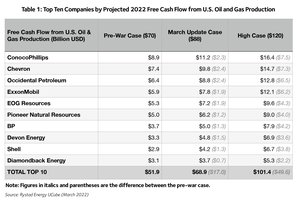This briefing is published by Oil Change International, Greenpeace USA and Global Witness.
With oil prices rising to near-record levels due to Russia’s ongoing war in Ukraine, companies producing oil and gas in the United States are in line to make tens of billions in additional profits. Using Rystad Energy’s Ucube database — a database that tracks the industry’s production economics at the well level — we can get an insight into how much money the industry is set to earn simply as a result of this massive price spike. Under conservative estimates, we find the US upstream oil and gas industry will collect a windfall of $37 to $126 billion in 2022 alone.[1]

We found that the US upstream industry is in line to earn an additional $37 billion if the current base case ($88) holds. If prices spike this summer and the 2022 average is closer to $120, earnings could soar by $126 billion compared to the pre-war case. Total projected free cash flow for 2022 would nearly double from $128 billion in the $70 scenario, to a potential $253 billion in the $120 scenario.
We also looked at the top ten earners. ConocoPhillips, Chevron and Occidental lead the pack with the potential to earn an additional $6.5 billion to $7.5 billion each if prices average $120. Together the top ten could earn additional profits just shy of $50 billion.
Oil executives have recently signaled that high oil prices may not lead to a rapid increase in domestic production.[2] US production is still quite high historically but is recovering from the Covid-19 downturn in oil demand,[3] and US drillers do not have the ability to immediately spin up new production. What’s more, pressure from Wall Street to impose “capital discipline” could lead these companies to pocket the gains from these high prices and return them to investors via dividends and buybacks.[4]

Much of this excess free cash flow that is boosting oil corporation balance sheets is flowing from the pocketbooks of US consumers. It is only right for Congress to pass a windfall profits tax and return some of these profits to consumers, as Sen. Sheldon Whitehouse and Rep. Ro Khanna recently proposed.[5] Despite misleading talk of “energy independence” from some politicians, the US can’t drill its way to lower gasoline prices. Thanks to the lifting of the crude oil export ban in 2015, US drillers are fully integrated with the global market; when crude prices increase globally, they also increase in the US. Booming US exports of liquefied natural gas (LNG) also tend to drive up domestic gas prices.[6]
If Congress had taken decisive action on climate change at any time in the last three decades the US economy would be more insulated against oil shocks, and would be enjoying the benefits of a renewable-powered economy that is healthier, more affordable, and more just. The answer to high gasoline prices is not to triple-down on a failed system.
Methodology
We use the Rystad Energy Ucube database to query the production and economics of the upstream oil and gas industry. Upstream refers to the exploration and extraction of oil and gas. Upstream profit, or free cash flow, is revenue flowing from oil and gas projects to these companies after taxes and royalties, capital expenditure and operating expenditure. Debt service or other corporate costs, e.g. executive salaries, have not been extracted from these revenues. This free cash flow is therefore the profit derived at the project level from selling oil and gas produced before corporate expenses have been paid. Much of it could be used for executive bonuses, share buybacks, and investor dividends.
This briefing was written by Lorne Stockman and David Tong (Oil Change International), Tim Donaghy (Greenpeace USA) and Zorka Milin (Global Witness).
For more information contact: Lorne Stockman ([email protected]) Tim Donaghy ([email protected]) or Zorka Milin ([email protected])
- Download a PDF version of this article (242.9 KB), pdf
[1] See Methodology below for methods and definitions.
[2] Paraskova, T. 2022. High Oil Prices Aren’t Enough To Tempt Shale Producers. Oil Price, March 1. [link]
[3] US Energy Information Administration. Crude Oil Production. [link]
[4] Stevens, P. 2022. Oil producers in a ‘dire situation’ and unable to ramp up output, says Oxy CEO. CNBC, March 8. [link]
[5] Sheldon Whitehouse Press Release, March 10, 2022 [link]
[6] Nalley, Stephen, Acting Administrator of US
Energy Information Administration, Statement before the US Senate Energy and
Natural Resources Committee, November 16, 2021. [link]


